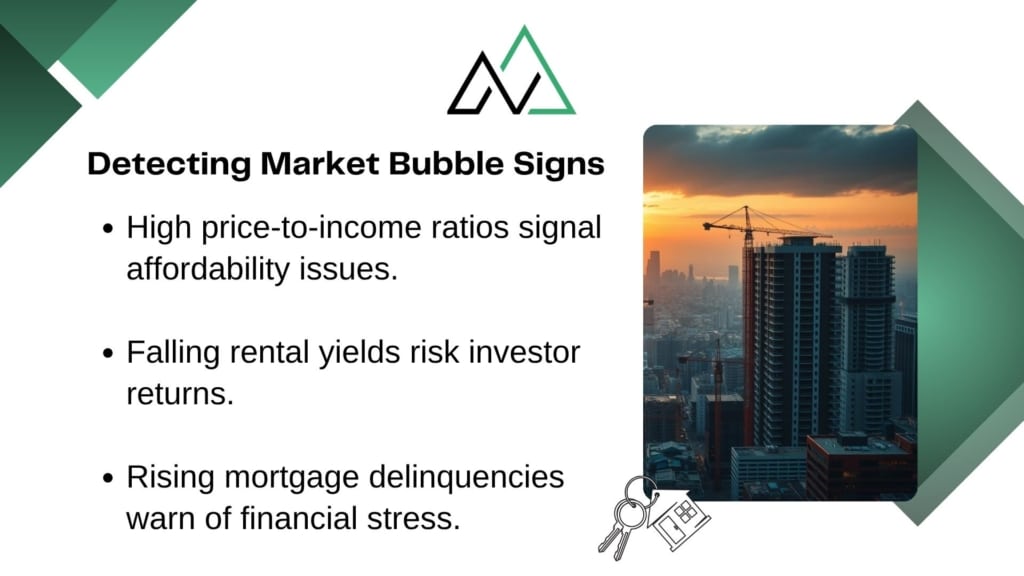In 2023, Canadian housing markets saw big changes. Prices dropped by up to 12% in big cities like Toronto and Vancouver. This has left many first-time buyers wondering if we’re seeing a speculative surge or just a temporary drop.
Understanding market cycles is key when dealing with these ups and downs.
Speculative buying and quick price changes often mean trouble ahead. For example, Calgary’s prices jumped 17% last quarter, and there’s less housing available. New Homes Alberta looks at these trends to help buyers see what’s real and what’s just a blip.
Whether you’re buying a home to live in or as an investment, knowing the warning signs is important. Things like interest rate changes, prices that are too high, and sudden construction stops are all red flags. Our team uses local data and years of experience to help clients make smart choices.
Key Takeaways
- Canadian markets show mixed signals with recent price corrections and regional demand spikes
- Historical patterns suggest specific metrics precede major market shifts
- Interest rates and housing inventory levels directly impact pricing stability
- Localized expertise helps interpret data for informed purchasing decisions
- Long-term planning reduces risks associated with short-term volatility
What Is a Real Estate Bubble
Real estate bubbles happen when prices grow too fast and don’t match the economy. They start with lots of demand and people buying without thinking. This makes prices go up too high for what people can afford.

Defining Market Volatility in Housing
The Canada Mortgage and Housing Corporation (CMHC) looks at three signs of a housing bubble. These are fast price increases, prices that are too high compared to what people earn, and too much debt. If prices go up by 10% or more each year without matching income or population growth, it’s a warning sign.
Markets can become unstable with sudden price changes and shifts in what buyers want.
Historical Examples in Canadian Markets
Canada’s real estate history shows ups and downs. Some areas bounce back fast, but others take longer. This is because of changes in rules and economic issues.
The 2008 Global Crisis Parallels
Canada was lucky in 2008 because of strict mortgage rules and safe banking. But now, there are new risks. More mortgages are insured, which helps lenders but makes buyers more vulnerable when prices drop.
Toronto’s 2017 Price Correction
Ontario’s Fair Housing Plan led to a 12% drop in Toronto’s detached home prices over 18 months. This left many buyers with homes worth 9-15% less than they paid. Toronto’s recovery is slow, unlike Vancouver’s, showing how local rules affect the market after a bubble bursts.
Causes of Real Estate Bubbles
Real estate bubbles don’t happen quickly. They are the result of many economic factors coming together. From cheap money to how investors think, let’s look at what drives Canada’s housing market.

Low Interest Rate Environments
Low borrowing costs create a perfect storm for housing demand. During the pandemic, Canadian mortgage rates fell below 4%. This allowed buyers to spend more:
- Average mortgage approvals increased 22% between 2020-2022
- Variable-rate mortgages made up 56% of new loans in 2021
- Calgary’s income-to-home-price ratio hit 42% by late 2022
But when rates go up, the illusion of affordability fades. This leaves homeowners in a tough spot.
Speculative Investment Patterns
Investors now make up 30% of Canadian home buyers, CMHC data shows. Many see homes as investments, hoping they’ll keep going up in value:
- Pre-construction condo flipping in Toronto jumped 68% in 2023
- Vancouver’s vacant home tax affects 1.2% of homes
This speculation warps the market, pushing prices too high for local incomes.
Foreign Buyer Influence in Canada
Foreign investment makes up only 2.4% of home purchases nationwide. But it’s more common in certain areas:
- 18% of Vancouver condos are owned by non-residents
- BC’s 20% foreign buyer tax cut offshore purchases by 87%
Supply Chain Constraints
Canada needs 3.5 million new homes by 2030 but is building too few. Material costs have risen 34% and labor is scarce.
Alberta’s Construction Permit Backlogs
Calgary’s 18-month wait for permits shows deep problems:
- Only 14,000 homes were started in 2023, despite 50,000 needed
- Construction costs in Alberta have gone up 27% from 2021
These delays keep the market tight, leading to fierce bidding wars even when prices are cooling.
Identifying Bubble Indicators

To spot a real estate bubble, we need to look at certain financial signs. These signs show if housing costs are out of balance with the economy. By checking affordability, rental returns, and debt, we can see if the market is getting too hot.
Price-to-Income Ratio Analysis
The price-to-income ratio compares home prices to what people earn. It shows if homes are affordable. If this ratio goes up fast, it means people are spending too much on homes.
Calgary vs National Averages
CMHC data shows Calgary’s ratio is 6.2. This means homes cost 6.2 times the average income there. This is higher than Canada’s average of 5.1. It shows Alberta buyers are facing more pressure.
When wages don’t grow with prices, markets often correct themselves. This is a sign of trouble ahead.
Rental Yield Compression
Rental yields shrink when home prices go up faster than rents. In Toronto, condos are now losing money after mortgage payments and fees. This is risky for investors who count on home value increases more than rental income.
Mortgage Debt Growth Trends
Equifax reports show mortgage delinquencies are up 25-36% in risky areas. Fast-growing debt and steady incomes are a bad mix. If interest rates go up or jobs become scarce, things could get worse. Watching these trends helps us see if the system is at risk.
Consequences of Bubble Bursts
When housing markets collapse, it’s like a wildfire spreading through personal finances, institutions, and economies. We’ll look at how these effects play out in real life. And why getting ready is so important.
Homeowner Equity Erosion
In Toronto, a 12% price drop left 1 in 8 homeowners with mortgages bigger than their homes’ value. This negative equity traps sellers, making it hard to cover closing costs. It also forces others to delay big plans like renovations or retirement.
Three main factors make things worse:
- Rising property taxes based on peak valuations
- Stagnant wages limiting repayment capacity
- Psychological stress leading to rushed sales
Banking Sector Vulnerabilities
Mortgage defaults soar when equity disappears. Canadian banks face a squeeze: their capital reserves shrink as home values drop, and loan loss provisions cut into profits. Smaller lenders, without a wide range of assets, risk running out of cash during long downturns.
CMHC Insurance Implications
2024’s new CMHC rules cap insured mortgages at 85% of appraised value for homes over $1 million. This change shifts risk to borrowers, making it harder to get a mortgage. It does this through:
- Larger down payment requirements
- Stricter debt-to-income ratios
- Reduced refinancing flexibility
Economic Domino Effects
Insolvencies jumped 29% year-over-year in Q1 2024 in Ontario and British Columbia. As people cut spending to pay off debts, retail and service sectors lose jobs. This creates a cycle of downturn that’s hard to break.
Construction slowdowns also hurt GDP growth. They could cut 1-2 percentage points off GDP each year during long corrections.
Preparing for Market Shifts
Dealing with real estate uncertainty means being proactive. By using OSFI mortgage renewal rules and the UBS Bubble Index, you can protect your money. Here are some steps to keep your assets safe from sudden market changes.
Stress-Testing Your Financial Resilience
Financial stress tests mimic bad scenarios. The Bank of Canada suggests checking your budget against possible rate hikes or income drops. Here’s how to do it:
- Calculate mortgage payments at 2% higher rates
- Review emergency fund coverage (aim for 6+ months of expenses)
- Analyze debt-to-income ratios using OSFI’s updated 2023 benchmarks
Smart Diversification Approaches
Diversifying investments can shield you from housing market ups and downs. Real estate is key, but also consider:
- REITs (Real Estate Investment Trusts)
- Mixed-use property investments
- Non-real estate assets like index funds
The UBS risk assessment model shows diversified portfolios do 34% better than single-asset strategies during Canadian bubbles.
New Homes Alberta Consultation Options
Getting personalized advice can make a big difference. New Homes Alberta’s certified advisors help you understand real estate bubble signs and make smart financial plans. Call them at (403) 305-9167 to get advice tailored to your situation with current market data and stress-test simulations.
Conclusion
Knowing what a real estate bubble is is key to making smart property choices. Places like Toronto and Vancouver show how prices can quickly get out of sync with the local economy. By watching signs like price-to-income ratios and mortgage debt, buyers can spot market changes early.
New Homes Alberta focuses on useful advice, not just warnings. History shows markets can adjust slowly or quickly. By testing finances and diversifying investments, buyers can lower risks, whether it’s their first home or more properties.
In Canada, housing data sends mixed messages. Calgary’s inventory is low, but Edmonton’s rental yields are stabilizing. This highlights the importance of local knowledge. Our team looks at both neighborhood trends and big-picture factors to help clients navigate tough times.
Real estate choices need a mix of hope and facts. Ignoring affordability can lead to trouble, while being too cautious might mean missing good chances. Tools like market analysis reports and equity dashboards help make complex ideas clear.
Being smart in the market pays off. Whether you’re watching for bubbles or exploring new areas, data is your ally. Check out New Homes Alberta’s resource center for the latest market updates and advice for your financial goals.


